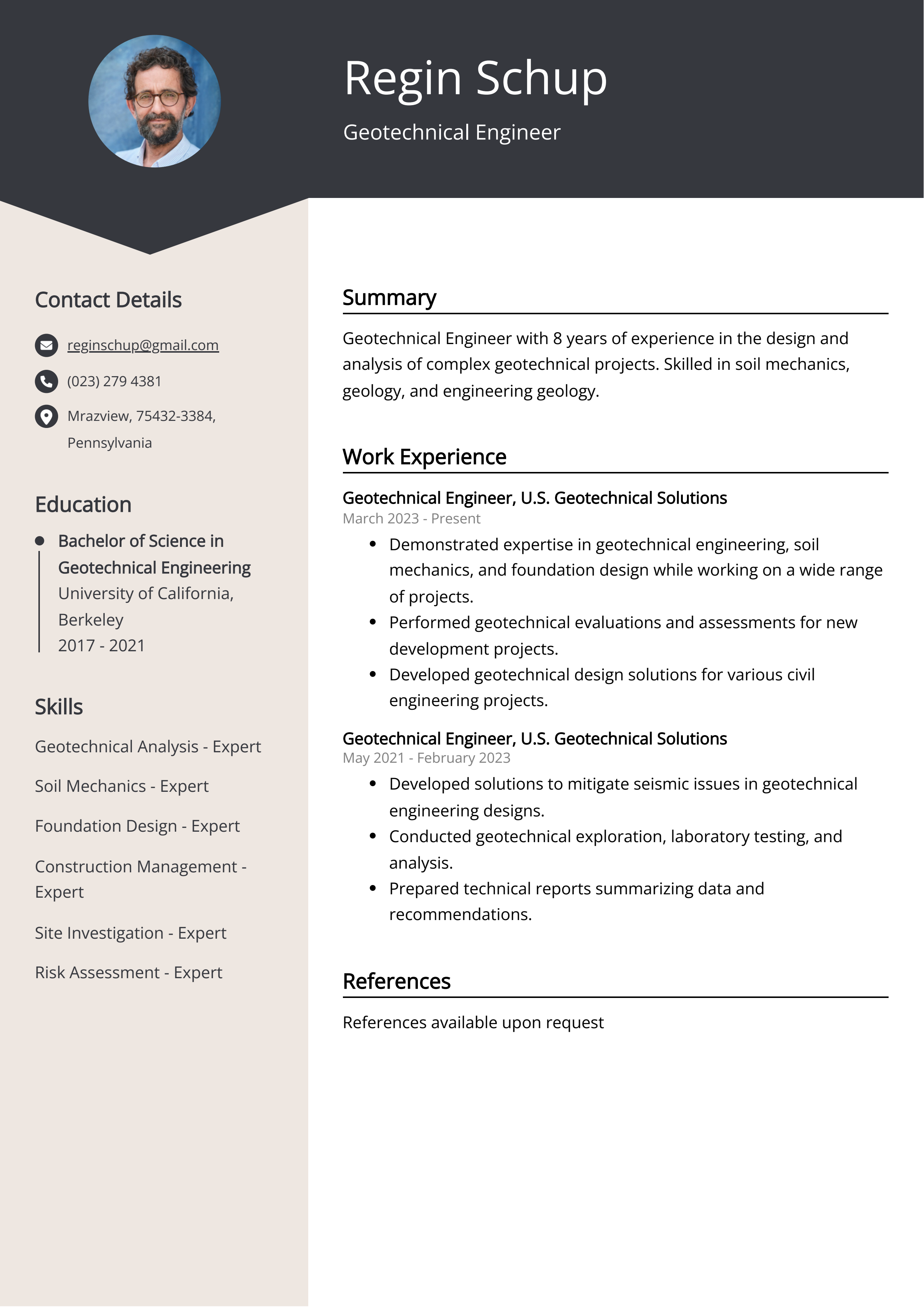The Ultimate Guide To Geotheta
The Ultimate Guide To Geotheta
Blog Article
About Geotheta
Table of ContentsThe Best Strategy To Use For GeothetaGeotheta Fundamentals ExplainedMore About GeothetaThe smart Trick of Geotheta That Nobody is DiscussingThings about Geotheta

They carry out site investigations, accumulate samples, do lab examinations, and examine information to review the suitability of the ground for building and construction jobs - Engineer of Record. Based upon their findings, geotechnical engineers offer recommendations for foundation design, slope stability, keeping structures, and reduction of geotechnical threats. They team up with other specialists, such as designers, structural engineers, and building teams, to guarantee that geotechnical considerations are incorporated into the overall project layout and execution
By analyzing the actions and residential or commercial properties of soil and rock, they can identify prospective geotechnical dangers such as landslides, soil negotiation, or slope instability. Their proficiency assists prevent failings or accidents that might jeopardize lives and property. Here are some in-depth responsibilities and duties of a geotechnical designer: Website Investigation: Geotechnical designers conduct site examinations to gather data on subsurface problems.
They translate the information to recognize the residential or commercial properties and behavior of the soil and rock, including their stamina, permeability, compaction characteristics, and groundwater conditions. Geotechnical Evaluation and Design: Geotechnical engineers assess the data collected during site examinations to examine the stability and viability of the site for building and construction jobs. They carry out geotechnical estimations and modeling to evaluate elements such as birthing capacity, negotiation, incline security, side earth stress, and groundwater flow.
Unknown Facts About Geotheta
Foundation Design: Geotechnical designers play an essential role in making foundations that can safely sustain the intended framework. They examine the soil problems and lots demands to figure out the proper foundation type, such as superficial foundations (e.g., grounds), deep structures (e.g (https://www.mixcloud.com/geotheta/)., piles), or specialized techniques like soil improvement. They consider factors such as negotiation restrictions, birthing ability, and soil-structure interaction to create optimum foundation designs
They assess building and construction plans, monitor website activities, and carry out area evaluations to verify that the layout suggestions are adhered to. If unexpected geotechnical issues occur, they analyze the scenario and provide referrals for remediation or adjustments to the style. Threat Evaluation and Reduction: Geotechnical engineers evaluate geotechnical hazards and risks associated with the task site, such as landslides, liquefaction, or dirt erosion.

Partnership and Communication: Geotechnical designers work very closely with other specialists included in a project, such as engineers, architectural engineers, and construction groups. Efficient interaction and collaboration are essential to incorporate geotechnical factors to consider into the total project layout and construction process. Geotechnical designers supply technical proficiency, response queries, and make sure that geotechnical requirements are satisfied.
Some Known Details About Geotheta
Right here are some kinds of geotechnical designers: Structure Designer: Structure designers specialize in developing and examining structures for frameworks. They assess the soil problems, tons needs, and website features to determine the most ideal structure kind and style, such as superficial foundations, deep structures, or specialized strategies like heap foundations.
They assess the elements influencing slope stability, such as soil properties, groundwater problems, and incline geometry, and develop strategies to avoid slope failures and reduce dangers. Quake Engineer: Earthquake designers concentrate on analyzing and designing frameworks to endure seismic forces. They evaluate the seismic risk of a website, examine soil liquefaction potential, and develop seismic layout standards to ensure the security and durability of structures throughout earthquakes.
They carry out field testing, collect examples, and assess the collected data to identify the dirt homes, geologic formations, and groundwater problems at a site. Geotechnical Instrumentation Designer: Geotechnical instrumentation designers focus on tracking and gauging the habits of dirt, rock, and structures. They mount and keep instrumentation systems that keep an eye on elements such as soil negotiation, groundwater levels, incline activities, and architectural displacements to examine performance and supply early warnings of potential problems.
7 Easy Facts About Geotheta Shown
They conduct tests such as triaxial examinations, debt consolidation tests, straight shear examinations, and permeability examinations to gather data for geotechnical analysis and layout. Geosynthetics Engineer: Geosynthetics engineers concentrate on the design and application of geosynthetic products, such as geotextiles, geogrids, and geomembranes. They make use of these materials to enhance dirt security, enhance inclines, supply drainage options, and control disintegration.
They often tend to be investigative individuals, which indicates they're intellectual, introspective, and investigative. They are curious, methodical, reasonable, logical, and sensible. Some of them are also social, indicating they're kind, charitable, participating, client, caring, helpful, compassionate, sensible, and pleasant. Does this noise like you? Take our cost-free career test to figure out if geotechnical engineer is just one of your leading job suits.
In the office environment, geotechnical designers make use of specialized software application tools to carry out computations, produce designs, and assess information. They prepare reports, review project specifications, communicate with clients and team participants, and coordinate task activities. The office setting provides a conducive setting for study, analysis, and collaboration with various other experts involved in the task.
The 3-Minute Rule for Geotheta
They regularly see job websites to conduct website examinations, evaluate geotechnical problems, and collect data for evaluation. These gos to entail taking a trip to different places, sometimes in remote or difficult surfaces. Geotechnical engineers may do soil sampling, conduct tests, and display construction tasks to make certain that the geotechnical aspects of the project are being carried out correctly.
Geotechnical designers also function in specialized geotechnical laboratories. In these centers, they perform experiments, carry out examinations on dirt and rock examples, and analyze the engineering buildings of the materials. Geotechnical laboratory engineers function thoroughly in these settings, taking care of testing tools, operating instruments, and videotaping information. They collaborate with other lab staff to guarantee precise and Geotechnical Engineers trustworthy screening outcomes.
Report this page